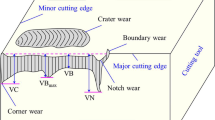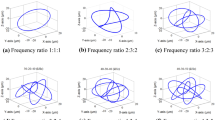Abstract
When processing difficult-to-cut materials, conventional turning (CT) typically suffers from the problems of large cutting force, difficult chip removal, and serious tool wear, resulting in deteriorated processing quality, reduced processing efficiency, and increased processing costs. In addition, special-purpose machine tools used for ultrasonic machining exhibit disadvantages, such as narrow application scope, high manufacturing cost, and poor universality; thus, they are not conducive to being popular in actual production and processing. Accordingly, this study analyzed the characteristics of ultrasonic wave, the mechanism of ultrasonic vibration-assisted turning (UAT), and the formation of a machined surface in UAT. Moreover, the machining system of UAT was established. This system applied an ultrasonic wave vibration device to an engine lathe to meet the requirements of vibration cutting in actual production. Simultaneously, Inconel 718, a typical and widely used difficult-to-cut material, was selected for the experimental study. The machining effect of UAT was analyzed in detail, including surface roughness, surface topography, and chip shape. Results indicated that ultrasonic amplitude, cutting speed, depth of cut, and feed rate exert considerable influences on the machining effect. UAT can achieve this effect, which is difficult to realize via CT, under the condition of a reasonable selection of technological parameters. This research can provide theoretical support and experimental basis for the development and practical application of UAT.
Similar content being viewed by others
Abbreviations
- CT:
-
Conventional turning
- UAT:
-
Ultrasonic vibration-assisted turning
- CNC:
-
Numerically controlled
- 3D:
-
Three-dimensional
- A :
-
Ultrasonic amplitude
- Vc :
-
Cutting speed
- ap :
-
Depth of cut
- f :
-
Feed rate
- Ra :
-
Surface roughness
References
T. M. Pollock and S. Tin, Nickel-based superalloys for advanced turbine engines: chemistry, microstructure, and properties, Journal of Propulsion and Power, 22 (2) (2006) 361–374.
G. J. Deng, S. T. Tu, X. C. Zhang, Q. Q. Wang and C. H. Qin, Grain size effect on the small fatigue crack initiation and growth mechanisms of Nickel-based superalloy GH4169, Engineering Fracture Mechanics, 134 (2015) 433–450.
C. Y. Hsu, Y. Y. Lin, W. S. Lee and S. P. Lo, Machining characteristics of Inconel 718 using ultrasonic and high temperature-aided cutting, Journal of Materials Processing Technology, 198 (1–3 (2008) 359–365.
M. C. Kushan, S. C. Uzgur, Y. Uzunonat and F. Diltemiz, Allvac 718 plus superalloy for aircraft engine applications, Recent Advances in Aircraft Technology, 2012 (2012) 75–95.
X. P. Ren and Z. Q. Liu, Influence of cutting parameters on work hardening behavior of surface layer during turning super-alloy Inconel 718, International Journal of Advanced Manufacturing Technology, 86 (5–8 (2016) 2319–2327.
S. J. Zhang, S. To, S. J. Wang and Z. W. Zhu, A review of surface roughness generation in ultra-precision machining, International Journal of Machine Tools and Manufacture, 91 (2015) 76–95.
P. Zou, Y. S. Xu, Y. He, M. F. Chen and H. Wu, Experimental investigation of ultrasonic vibration assisted turning of 304 austenitic stainless steel, Shock and Vibration, 2015 (2015) 817598.
C. Nath and M. Rahman, Effect of machining parameters in ultrasonic vibration cutting, International Journal of Machine Tools and Manufacture, 48 (9) (2008) 965–974.
C. Nath, M. Rahman and S. S. K. Andrew, A study on ultrasonic vibration cutting of low alloy steel, Journal of Materials Processing Technology, 192 (2007) 159–165.
M. Xiao, Q. M. Wang, K. Sato, S. Karube, T. Soutome and H. Xu, The effect of tool geometry on regenerative instability in ultrasonic vibration cutting, International Journal of Machine Tools and Manufacture, 46 (5) (2006) 492–499.
M. Zhou, X. J. Wang, B. K. A. Ngoi and J. G. K. Gan, Brittleductile transition in the diamond cutting of glasses with the aid of ultrasonic vibration, Journal of Materials Processing Technology, 121 (2–3 (2002) 243–251.
T. B. Thoe, D. K. Aspinwall and M. L. H. Wise, Review on ultrasonic maching, International Journal of Machine Tools and Manufacture, 38 (4) (1998) 239–255.
M. A. Xavior and M. Adithan, Determining the influence of cutting fluids on tool wear and surface roughness during turning of AISI 304 austenitic stainless steel, Journal of Materials Processing Technology, 209 (2) (2009) 900–909.
V. Ostasevicius, R. Gaidys, J. Rimkeviciene and R. Dauk-sevicius, An approach based on tool mode control for surface roughness reduction in high-frequency vibration cutting, Journal of Sound and Vibration, 329 (23) (2010) 4866–4879.
L. B. Abhang and M. Hameedullah, Parametric investigation of turning process on en-31 steel, Procedia Materials Science, 6 (2014) 1516–1523.
Y. He, P. Zou, W. L. Zhu and K. F. Ehmann, Ultrasonic elliptical vibration cutting of hard materials: simulation and experimental study, International Journal of Advanced Manufacturing Technology, 91 (1–4 (2017) 363–374.
S. Koshimizu, Ultrasonic vibration-assisted cutting of titanium alloy, Key Engineering Materials, 389–390 (2009) 277–282.
A. Maurotto, R. Muhammad, A. Roy and V. V. Silberschmidt, Enhanced ultrasonically assisted turning of a β-titanium alloy, Ultrasonics, 53 (7) (2013) 1242–1250.
K. M. Hu, S. L. Lo, H. B. Wu and S. To, Study on influence of ultrasonic vibration on the ultra-precision turning of Ti6Al4V alloy based on simulation and experiment, IEEE Access, 7 (2019) 33640–33651.
S. Patil, S. Joshi, A. Tewari and S. S. Joshi, Modelling and simulation of effect of ultrasonic vibrations on machining of Ti6Al4V, Ultrasonics, 54 (2) (2014) 694–705.
B. Gholamzadeh and H. Soleimanimehr, Finite element modeling of ultrasonic-assisted turning: cutting force and heat generation, Machining Science and Technology, 23 (6) (2019) 869–885.
M. Xiao, S. Karube, T. Soutome and K. Sato, Analysis of chatter suppression in vibration cutting, International Journal of Machine Tools and Manufacture, 42 (15) (2002) 1677–1685.
Y. S. Xu, P. Zou, Y. He, S. Chen, Y. J. Tian and X. J. Gao, Comparative experimental research in turning of 304 austenitic stainless steel with and without ultrasonic vibration, Proceedings of the Institution of Mechanical Engineers Part C-Journal of Mechanical Engineering Science, 231 (15) (2017) 2885–2901.
Y. S. Xu, Z. H. Wan, P. Zou and Q. J. Zhang, Experimental study on chip shape in ultrasonic vibration-assisted turning of 304 austenitic stainless steel, Advances in Mechanical Engineering, 11 (8) (2019).
M. C. Shaw and A. Vyas, The mechanism of chip formation with hard turning steel, CIRP Annals — Manufacturing Technology, 47 (1) (1998) 77–82.
M. H. Xiao, N. He, L. Li and H. B. Liu, Experimental studies on notch wear for high speed machining of nickel-based superalloy with ceramic tools, China Mechanical Engineering, 19 (10) (2008) 1188–1192.
Acknowledgments
This work is supported by the Research Program of the Open Foundation of Jiangxi Province Engineering Research Center of New Energy Technology and Equipment, East China University of Technology (No. JXNE2019-03), the Science and Technology Research Project of Jiangxi Provincial Education Department, China (No. GJJ190370), the Natural Science Foundation of Jiangxi Province, China (No. 20202BAB204021), and the East China University of Technology Research Foundation for Advanced Talents (No. DHBK2016113).
Author information
Authors and Affiliations
Corresponding author
Additional information
Yingshuai Xu obtained his Ph.D. in Mechanical Manufacturing and Automation from Northeastern University, Shenyang, China in 2016. He is currently a lecturer at the School of Mechanical and Electronic Engineering, East China University of Technology, Nanchang. His research interests include ultrasonic vibration-assisted turning, milling and drilling of difficult-to-cut materials, cutting simulation, and faulty diagnosis.
Rights and permissions
About this article
Cite this article
Xu, Y., Gao, F., Zou, P. et al. Theoretical and experimental investigations of surface roughness, surface topography, and chip shape in ultrasonic vibration-assisted turning of Inconel 718. J Mech Sci Technol 34, 3791–3806 (2020). https://doi.org/10.1007/s12206-020-0830-x
Received:
Revised:
Accepted:
Published:
Issue Date:
DOI: https://doi.org/10.1007/s12206-020-0830-x




